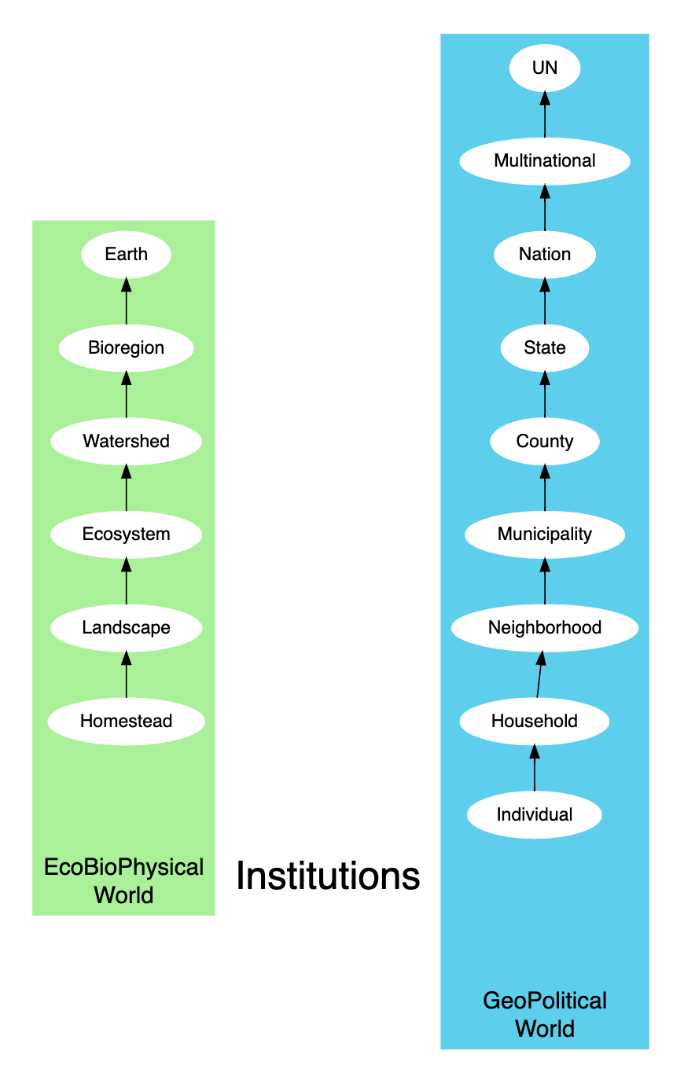Here we aspire to do work as well as talk about doing work. To this end we add code and data to our environment. Now we consider how code and data can situate the work we do in the larger context of other's work and the natural and political environments that limits all activity. >> survey search overview
We refer to organized humans at all scales as "institutions". We have considered elsewhere what binds a particular institution but now address how these operate in a network that can expand beyond the cognitive horizon of any member but still has bearing on the success of effort from various perspectives.
We propose here an annotation to be applied to any relevant wiki page that names the institution involved and lists relationships critical to the work described.
We describe how these annotations can be collected by mechanical survey and assembled as nodes in a network of unbounded complexity.
We show how subsets of this network can be retrieved based on current needs and interests and rendered as a browsable diagram designed to situate such extractions in the ecological and political hierarchies that always exist.
# Annotation
We write annotations as a single item, compose of multiple lines, represented in markdown but without any markdown special characters other than newline.
The first line of an annotation begins with the all-caps keyword INSTITUTION followed by the name by which the institution will be known in the network we construct. This need not be a full proper name but it should be complete enough to be recognized in many contexts.
The remaining lines of an annotation lists relations with other institutions and sometime their further relations when this is important. All relations begin with the two-character arrow, =>, pointing to the first of a list of relations and then, when necessary, an => separated list of further relations.
INSTITUTION Senate => State Government => Congress => State People => Executive => Electors => State Elections => Supreme Court => Nomination => Confirmation
# Survey
We expect the format of annotations to be unique enough that they are not easily confused with other content on wiki pages. We use the recently developed Survey machinery to find all of the annotations within the pages of participating federated wiki sites.
The information collected by Survey comes from a small function called a Probe. We've created one for finding and interpreting institution annotations. Probes are themselves described in wiki "survey probe" pages which include a means of testing a probe's behavior and launching new surveys with the probe.
A wiki site author can drag this survey probe to their own site and click "launch" to participate in this institutional network modeling.
# Diagram
This network modeling effort has been inspired by Marc Pierson's "situated organizations" variation on recursively hierarchical Viable Systems Model. Here we show how to select content from institution surveys and render it within the diagram Marc has designed.
We begin the diagramming process by assembling the necessary information on a wiki page one creates to identify the participating sites, identify one or more institutions with these sites, and hold the script that brings these together.
We identify participating sites by referencing the survey result page on each site. This is the community of interest. A Reference item is created by dragging the survey result page flag to the new item factory. Click [+] to create a new item factory.
We will grow a diagram from one or more institutions identified as initiators. Create an INSTITUTION annotation for each of these. Include relations that are or will lead to the other institutions of interest for the diagram.
The script to bring these two resources together and start the drawing can be found on our sample diagram. The "preview" button will open a new page with the initiating sites diagramed and a second script ready to continue adding additional community institutions.
The diagrams created are not yet published pages in a wiki site so they are shown as transparent "ghost" pages. A ghost page can be forked to save and publish it as a normal page. Or elements from the ghost page can be dragged in tact to other pages where they will be useful.
